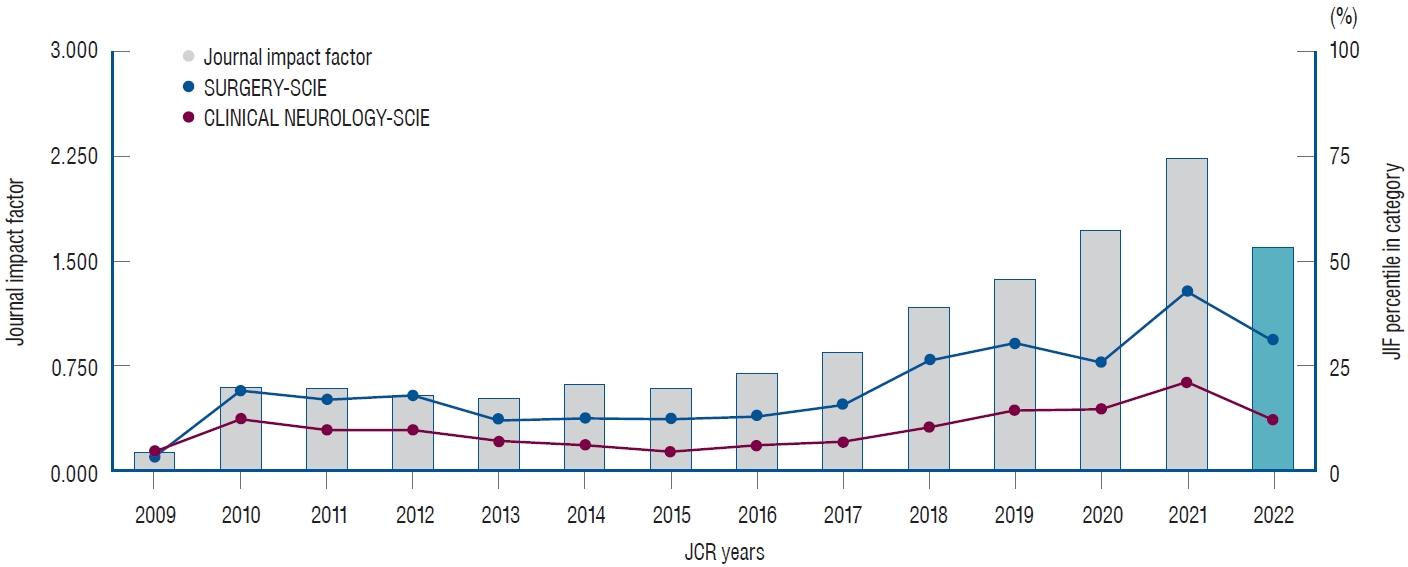Yang: Journal Citation Report 2022 and Impact Factor of Journal of Korean Neurosurgical Society
Brief overview of the journal citation reports (JCR)
It is estimated that there are about 30000 medical journals published in the world [ 5]. However, only a few of them have considerable influence. In this situation, all academic journals are making constant efforts to increase their influence, and in that sense, they pay a lot of attention to the impact factor (IF) and are trying to improve it. There is a negative view of overemphasizing the impact index, and it is reported that the IF is influenced by relatively small portion papers published in academic journals [ 6]. Nevertheless, it cannot be denied that the citation quota index is the most widely used quantifiable indicator at the present time.
Status of Journal of Korean Neurosurgical Society (JKNS) in 2022 JCR
The 2022 Impact Factor (IF) of the JKNS was 1.6, which is a 29% decrease from last year (2.249), similar to that of 2020 (1.729) [ 1- 3] ( Fig. 1). The decrease in the IF marks a reversal of the previously consistent trend of continuous increase, and this downturn is undeniably disappointing. Therefore, it is imperative to identify the underlying cause and devise strategies to enhance it again. It is known that IF is determined by the number of citations and number of articles published. The changes of citations and citable items in recent 4 years are summarized in Table 1. It is noteworthy that the number of citable items is at its lowest in 2021, while the number of citations is at its highest when the IF is at its peak. The low IF of 2022 can be arithmetically deduced from the rise in citable items coupled with a decline in citations. The other factors to be noted are peak citation and percent of articles without citation, the former is beneficial to increase in IF, the latter is detrimental. It is not easy to filter out papers that will not get citations during the process of review before publication. It would be advantageous to filter papers of high scientific value during the assessment process. One approach is to revise the papers to address any shortcomings, while another approach is to reject them if they are deemed difficult to improve even after appropriate revisions. It is also noteworthy that there are differences in citation rates across different types of articles. Review articles tend to receive more citations than original articles, whereas case reports receive the fewest citations ( Table 2). However, it is important to mention that original articles often have the highest citation rates. Given this pattern, it is crucial to select a compelling topic and encourage the submission of high-quality original articles and review articles to maintain the IF and to motivate the members of Korean Neurosurgical Society (KNS). As for case reports, it is advisable to carefully select only a small portion of submitted manuscript with a high likelihood of citation. The recent development of JKNS can be attributed to the combined efforts of the KNS members, authors and editorial board [ 4]. However, the IF of JKNS is currently in a transitional state, and it is uncertain whether it will increase, decrease, or remain at present level in the coming years. Nevertheless, it has been established that continuous interest and effort put into JKNS have contributed to its progress in recent years. Therefore, it is imperative that we exert even more effort than ever before to further the development of JKNS.
Fig. 1.
Trends in years of the journal impact factor (JIF) and its percentile rank in category of the Journal of Korean Neurosurgical Society. Adapted from the 2022 journal citation reports (JCR) [ 3]. 
Table 1.
Change of citations, citable items, peak citation, articles without citations of JKNS
|
Year |
Impact factor |
Citation |
Citable item |
Peak citation |
Articles w/o citation |
|
2019 |
1.4 |
267 |
194 |
10 |
71 (36.6) |
|
2020 |
1.7 |
294 |
170 |
12 |
56 (32.9) |
|
2021 |
2.2 |
380 |
169 |
14 |
38 (22.5) |
|
2022 |
1.6 |
302 |
189 |
8 |
59 (31.2) |
Table 2.
Citations according to type of articles
|
Number |
Citation |
Citations per article |
|
Original article |
142 |
206 |
1.45 |
|
Review |
43 |
85 |
1.98 |
|
Case report |
4 |
3 |
0.75 |
References
6. Larivière V, Kiermer V, MacCallum CJ, McNutt M, Patterson M, Pulverer B, et al : A simple proposal for the publication of journal citation distributions. BioRxiv 2016, [Epub ahead of print] 
|
|

















